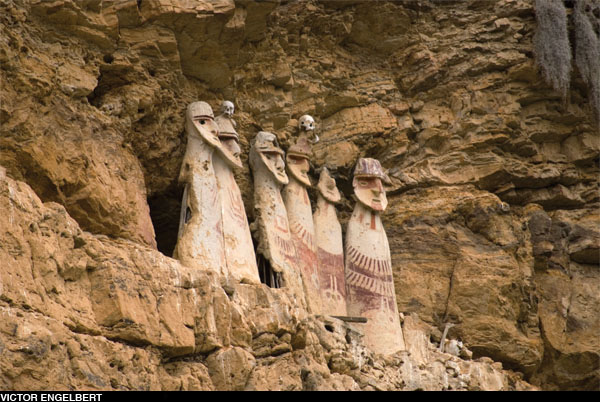 While some Chachapoya elite were buried in standing clay and grass effigies, as at Karijia, others were entombed in chullpas, brightly painted cliffside tombs, such as those found at the site of Revash. Painted in shades of red and cream, many of the chullpas have gabled roofs and are embellished with cross-shaped niches. Local farmers call the red markings and targetlike circles ojos, or eyes--ancestors keeping tabs on the living.
While some Chachapoya elite were buried in standing clay and grass effigies, as at Karijia, others were entombed in chullpas, brightly painted cliffside tombs, such as those found at the site of Revash. Painted in shades of red and cream, many of the chullpas have gabled roofs and are embellished with cross-shaped niches. Local farmers call the red markings and targetlike circles ojos, or eyes--ancestors keeping tabs on the living.

On a cliff ledge overlooking the vast Utcubamba Valley I spot five-foot-tall anthropomorphic sarcophagi of six ancient Chachapoya, gazing at the rising sun, as if the dead were watching over the living. The capsulelike coffins, made of clay and grass, and built into the cliff face between A.D. 1100 and 1300, are shielded from the rain by overhanging rock. Within them are mummy bundles holding the remains of Chachapoya elite. To reach the cliff heights, the Chachapoya may have used natural ledges, which were destroyed when they withdrew. Scholars believe a stone wall was erected around each mummy bundle. Cane poles were inserted into the walls, sort of teepee-style, and the capsules were built up and then painted. The effigies were finally "dressed" in feathered tunics and adorned with necklaces and trophy heads. The skulls may have been part of the decoration. The site is called Karijia, after a canyon below; the sarcophagi are known to locals as "ancient wise men."

It may not be Machu Picchu, but the Kuelap citadel, the largest Chachapoya fortress-city by far, is an impressive place built more than 1,000 years ago. Protected on one side by a sheer drop, it stands at an elevation of 9,500 feet and is surrounded by a dense forest. A 65-foot wall of pale yellow stones surrounds some 420 houses and ceremonial structures, many of them still buried under trees and vegetation that include colorful bromeliads and orchids. Three funnel-like entrances further protected the site from intruders. Many of the walls within the 15-acre fortress display friezes that may be stylized eyes of a puma, one of the Chachapoya's four animal deities. With some 3,500 inhabitants at its height, Kuelap (the name suggests a fortified settlement) was a big town for its time. While it was known to the Spanish, who collected tribute from the people who lived there, the first archaeological investigation of the site was carried out by an Italian, Antonio Raimondi, in 1860.

Utcubamba Valley